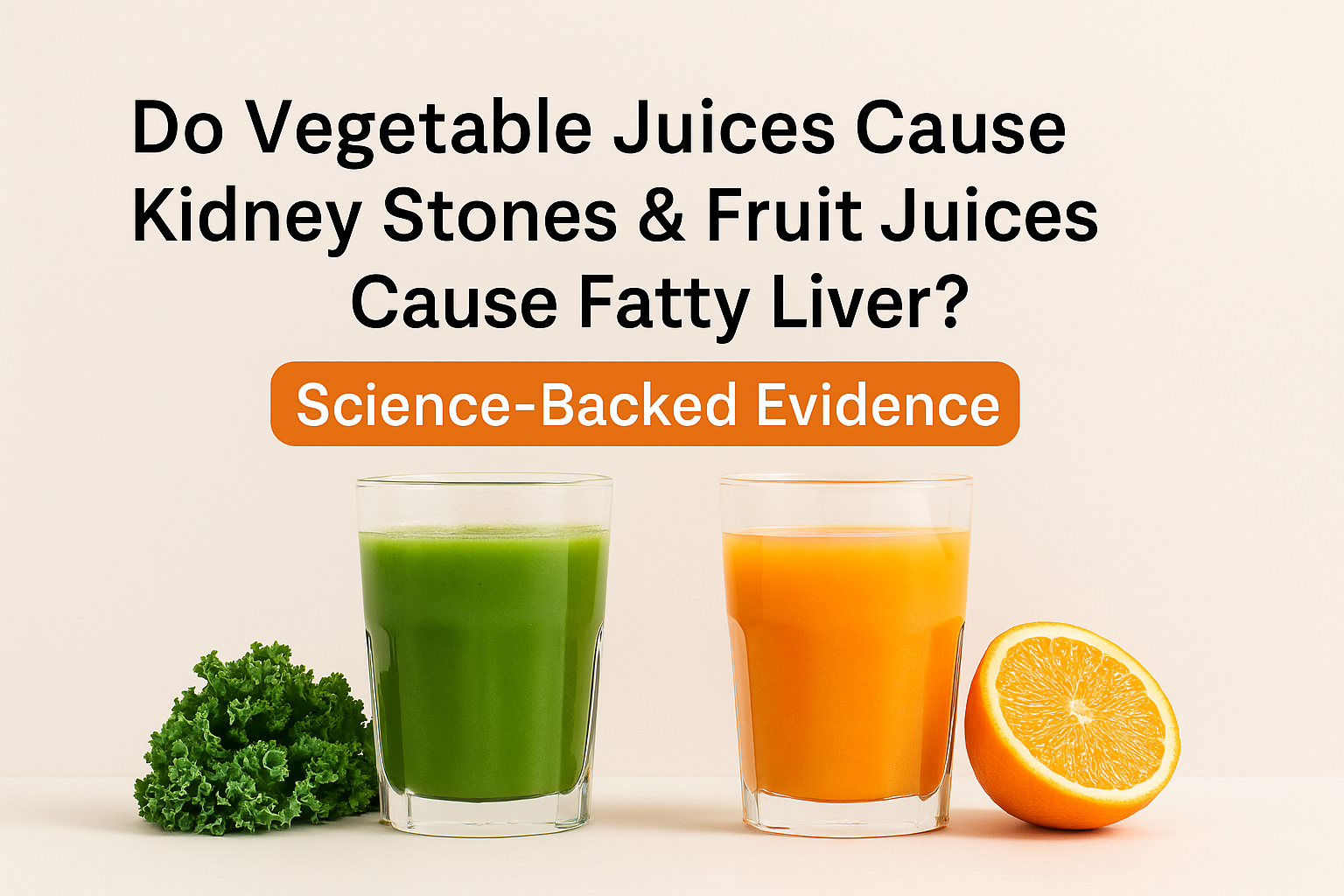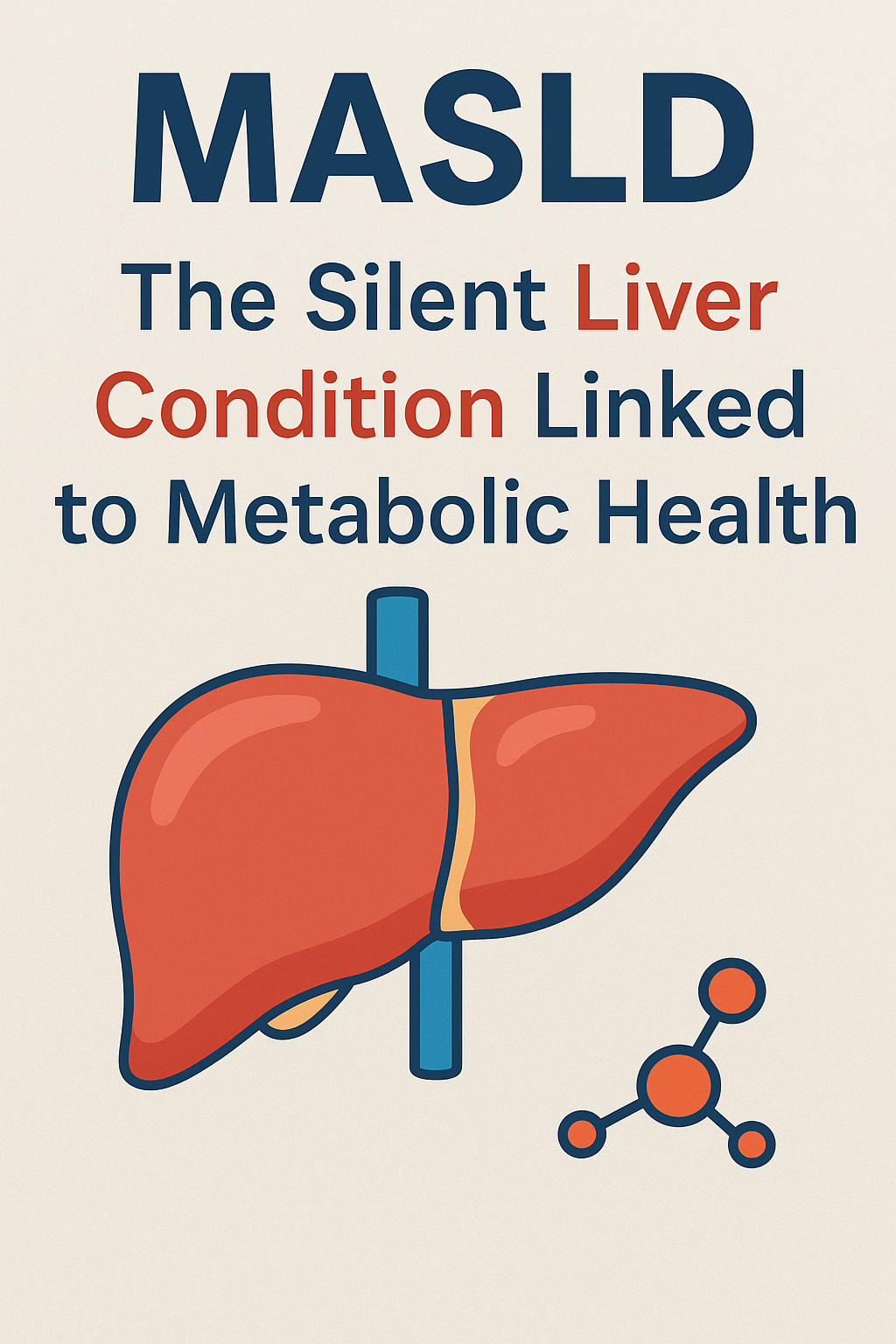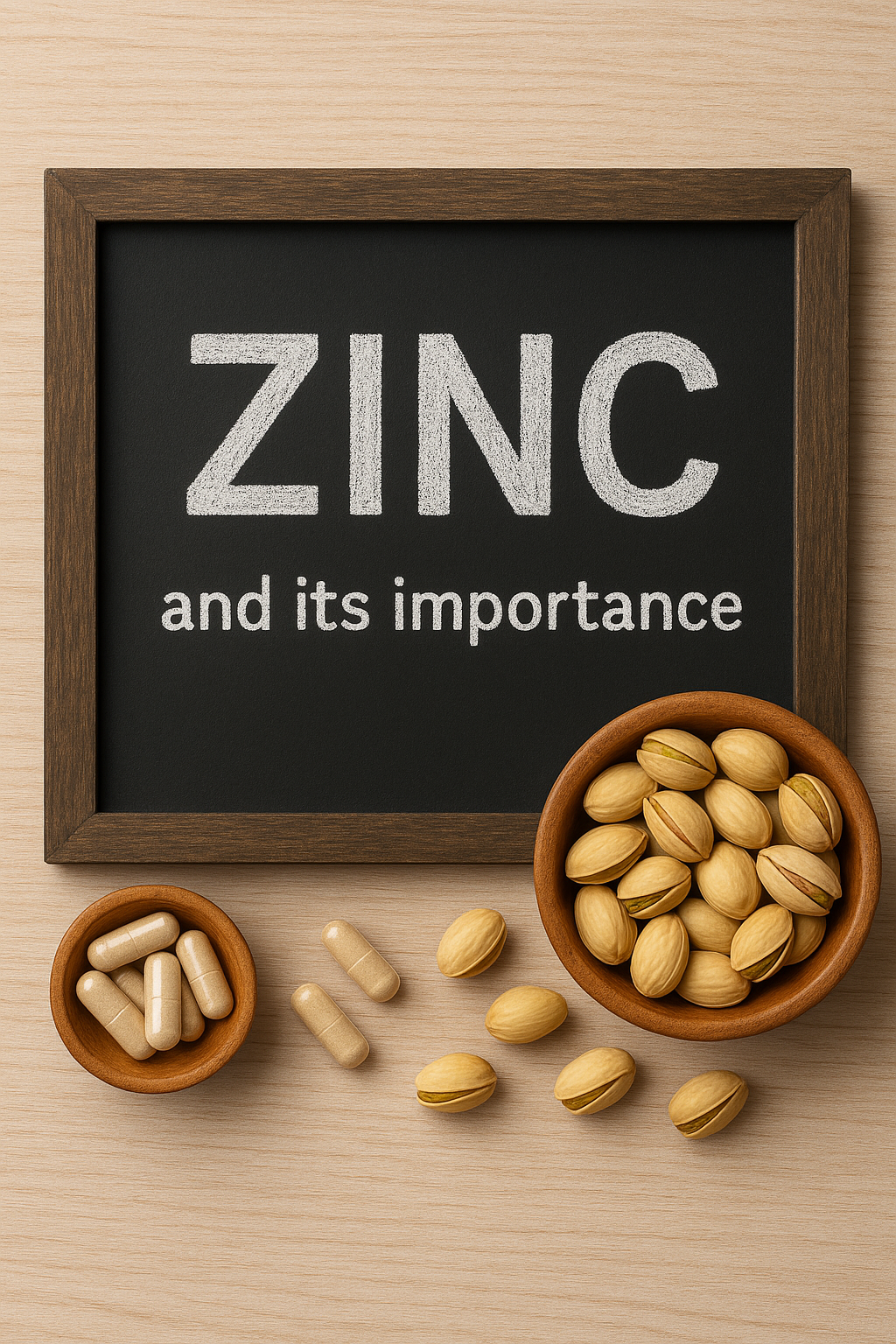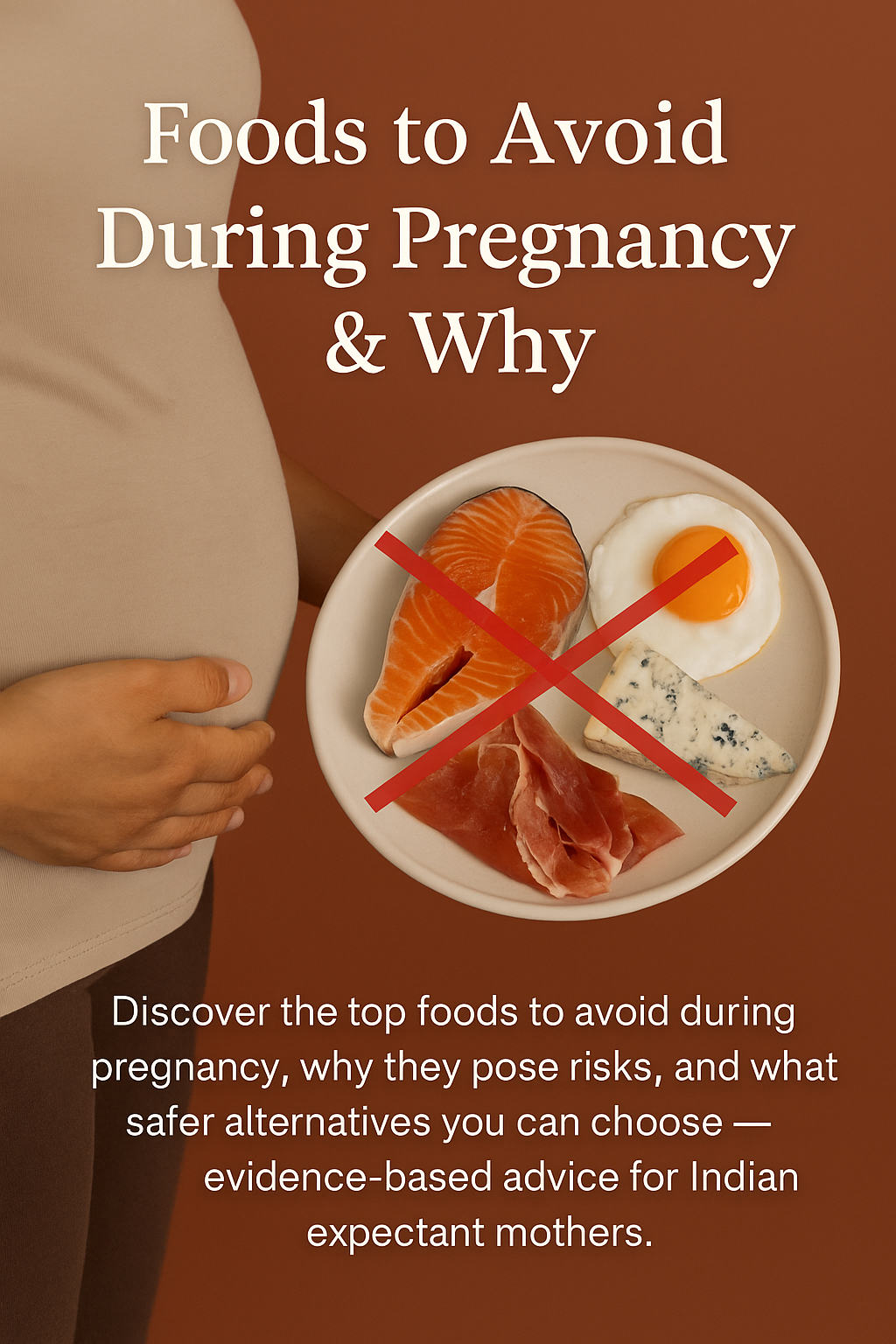A science-backed explainer by Dr Akanksha (MD)
Bottom line (in two lines)
-
Vegetable juices: No, they don’t automatically cause kidney stones—but frequent/high-volume juicing of oxalate-rich greens (e.g., spinach, beet greens) can raise urinary oxalate and has been linked to oxalate nephropathy and calcium-oxalate stones in susceptible people. Risk depends on what you juice, how much, and your background risk.
-
Fruit juices: No, they don’t inevitably cause fatty liver—but regular/excess intake of fructose-rich, sugar-sweetened beverages (including many commercial “fruit drinks”) increases liver fat and NAFLD/MASLD risk, especially in a calorie surplus. Whole fruit behaves differently.
Part A — Vegetable juices & kidney stones
Why oxalate matters
Most kidney stones are calcium-oxalate. Dietary oxalate (abundant in spinach, beet greens, Swiss chard, almonds, sesame, soy, rhubarb, cocoa) increases urinary oxalate in many people; higher urinary oxalate promotes stone formation. Juicing removes much of the insoluble fiber and can condense oxalate load per glass.
What the evidence shows
-
Mechanism & epidemiology: Reviews explain how net gut oxalate absorption drives urinary oxalate and stone risk; diet composition (calcium with meals, fat malabsorption, gut microbiome) modifies absorption.
-
Case reports/series: “Green smoothie/juicing cleanses” with heavy spinach have caused acute oxalate nephropathy and even dialysis-requiring AKI in at-risk adults (e.g., prior bariatric surgery, antibiotics, low calcium intake). These are uncommon but cautionary.
Who is at higher risk?
-
Prior calcium-oxalate stones, chronic kidney disease, enteric hyperoxaluria (fat malabsorption, IBD, bariatric surgery), very low dietary calcium, high-dose vitamin C (metabolized to oxalate).
Practical takeaways for juicing
-
Rotate greens; don’t default to spinach/beet daily. Prefer lower-oxalate options (kale, lettuce, cucumber, zucchini, cabbage). (Mechanistic guidance from oxalate reviews.)
-
Pair oxalate-containing foods with calcium (e.g., curd/yogurt, tofu set with calcium) in the same meal to reduce absorption.
-
Boil & discard water for high-oxalate vegetables before blending (boiling leaches soluble oxalate).
-
Hydrate; target urine output ≥2–2.5 L/day and add citrate sources (lemon/lime) if appropriate.
-
Avoid megadose vitamin C (>1 g/day) if stone-prone. (Converts to oxalate; discussed in reviews.)
-
If you’ve had stones, ask for a 24-hour urine to personalize oxalate/sodium/citrate/calcium targets.
Verdict: Vegetable juices do not universally cause stones; the risk emerges with high-oxalate recipes consumed frequently, combined with individual susceptibility.
Part B — Fruit juices & fatty liver (NAFLD/MASLD)
Fructose, calories, and liver fat: what we know
-
Guidelines from AASLD/AGA and recent reviews consistently advise limiting SSBs for NAFLD risk reduction and treatment.
-
Observational cohorts link daily SSB intake to higher NAFLD prevalence, liver cancer incidence, and chronic liver disease mortality (population-level signals; causality cannot be proven but aligns with metabolic mechanisms).
Where do 100% fruit juices fit?
-
Isocaloric trials suggest that when total calories are held constant, some juices (e.g., orange juice) don’t necessarily worsen—and may sometimes modestly improve—select metabolic markers in MASLD; duration is short and findings are not universal. Whole fruit still outperforms juice for satiety/fiber.
-
Cross-sectional data tying specific fruits/juices to NAFLD exist but are inconsistent and may reflect overall diet/lifestyle patterns and misclassification between 100% juice vs sweetened “fruit drinks.”
Practical takeaways for fruit juice
-
Prioritize whole fruits (fiber slows fructose absorption, improves satiety). Limit juice to ~120–150 mL/day (½–¾ cup) within calorie targets, especially if you have insulin resistance, hypertriglyceridemia, or NAFLD. (Guideline-consistent advice.)
-
Avoid/limit SSBs and commercial “fruit drinks” with added sugars or concentrates; these are the strongest NAFLD signals.
-
If using juice, pair with protein/fiber (e.g., nuts/Greek yogurt), or use citrus wedges/infusions instead of full glasses of juice to flavor water.
Verdict: Fruit juice in moderation and within calorie limits is unlikely to cause fatty liver in otherwise healthy, active people—but habitual high-volume, sugar-sweetened beverages (and any juice consumed on top of surplus calories) do increase risk.
Conclusion
Both vegetable and fruit juices have been over-simplified in wellness trends. Scientific evidence shows that:
-
Vegetable juices are safe for most people when made with a variety of greens and consumed moderately. However, excessive intake of high-oxalate vegetables such as spinach, beetroot, or Swiss chard in daily juicing routines can elevate urinary oxalate and increase the risk of calcium-oxalate kidney stones, particularly in individuals who are already predisposed.
-
Fruit juices, especially commercially sweetened ones, can contribute to fatty liver (NAFLD/MASLD) due to their fructose and calorie load when consumed regularly and in excess. Yet, small servings of 100% fruit juice within an otherwise balanced diet are not shown to independently cause liver fat accumulation.
In short:
Juices are not inherently harmful—but concentrated, frequent juicing without awareness of oxalate, fructose, and calorie balance can create problems. Moderation, variety, hydration, and fiber (from whole produce) remain key to kidney and liver health.
References (PubMed/PMC)
-
Mitchell T, et al. Dietary oxalate and kidney stone formation. Urolithiasis. 2019; review. PubMed (Open-access summary) PMC
-
Crivelli JJ, et al. Contribution of dietary oxalate and oxalate precursors to urinary oxalate… Curr Opin Nephrol Hypertens. 2020. PubMed
-
Getting JE, et al. Oxalate nephropathy due to “juicing”: case report and review. Am J Med. 2013. PubMed
-
Makkapati S, et al. “Green Smoothie Cleanse” causing acute oxalate nephropathy. Am J Med Sci. 2018. PubMed
-
Chaudhari H, et al. Acute oxalate nephropathy caused by excessive dietary oxalate. Cureus. 2022. PMC
-
Jensen T, et al. Fructose and sugar: a major mediator of NAFLD. Hepatology. 2018; review. PMC
-
Lee D, et al. Fructose in SSBs increases NAFLD markers (systematic review/meta-analysis). Nutrients. 2022. PubMed
-
Asgari-Taee F, et al. SSBs and NAFLD risk (meta-analysis). Nutrition & Metabolism. 2019. PubMed
-
Zhao L, et al. SSB intake, liver cancer incidence, and chronic liver disease mortality (WHI cohort). JAMA. 2023. PubMed
-
AASLD Practice Guidance (2023): Assessment & management of NAFLD/MASLD—limit SSBs/excess fructose. PMC
-
AGA Clinical Practice Update (2021/2022): Lifestyle guidance in NAFLD. PubMed
-
Zelber-Sagi S, et al. Practical lifestyle management of NAFLD (2024 review). Nutrients. 2024. PMC
-
Naomi ND, et al. SSB, low/no-calorie beverages & fruit juice vs NAFLD across cohorts. JHEP Reports. 2023. PMC
-
Notarnicola M, et al. Daily orange (whole fruit) & MASLD markers (trial). Nutrients. 2024. PubMed
-
Notarnicola M, et al. Short-term orange juice & lipid metabolism (pilot). Nutrients. 2024. PMC
-
Semmler G, et al. Diet & NAFLD overview. Viszeralmedizin/Hepatology reviews. PMC

Akanksha Sharma
Dr. Akanksha Sharma, Head Writer and creator of AtoZ of Pregnancy, is dedicated to empowering women, parents, and families through 360-degree knowledge. She and her team provide evidence-based advice to guide families through pregnancy, parenting and beyond.






